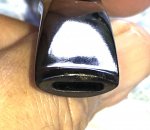The short version, from Rob Cooper:
"There were three periods of pipe craftsmanship that took place during the tenure of Ole Larsen's ownership and stewardship of the Larsen name.
The first period, or the "Copenhagen Era" (Very early 1960's to the early 1970's) (The pipes were stamped "Larsen (over) Copenhagen") are the ones that have dominated my pipe collection. They are the pipes that were crafted by Poul Rasmussen (the former husband of Anne Julie), Sven Knudsen (Teddy's older brother and mentor), and Hans "Former" Nielsen (when he was just a youngster!). These pipes were produced in two series - numbered standard shapes and one of a kind "Straight Grain" handmade freehands. The pipes of this era were crafted from Algerian briar, according to my friend Former Nielsen (he would know!). There were even two series of the numbered pipes, as the production facility suffered a fire and the master shapes had to be re-carved! The "Straight Grain" pipes were typically stamped from F, then 1 to 6 in ascending grade order. There were no "Pearls" crafted at this time. The highest grades were stamped as high as an "8", but these were extremely rare. The stamping grades of from this era were much more stringent than in later times. The majority of the "Straight Grain" pipes from this era were finished in a light to medium natural stain. Most shank adornments were crafted from buffalo horn of a lighter color. These "Copenhagen" era pipes are considered by pipe collectors around the world as the most desirable, as these are prime examples of mid century modern Danish design that were crafted by the early masters of the pipe making art. These are the most organic looking and the most important as far market desirability is concerned.
The second period (Mid 1970's to the mid to late 1980's) is the most famous period, as this is the era of Teddy Knudsen, Tonni Nielsen, and Former Nielsen, along with the occasional pipe crafted by Jess Chonowitsch, Peter Hedegaard, PH Vigen, and a few others. These pipes were stamped "Larsen Hand Made in Denmark" with no "Copenhagen" stamping. The staining of the bowls were more varied than the era before. The pipes crafted during this time began to show a more refined shaping, and the use of adornment materials expanded from lighter colored horn to now a darker color, bamboo, ivory, amber composite both for trim and stem work, and later in this period, some exotic hardwood for the trim, as Ole had explained to me that ivory was not as stable on airplane shipping and would sometimes arrive cracked. The pipes of this era are the most commonly found."























